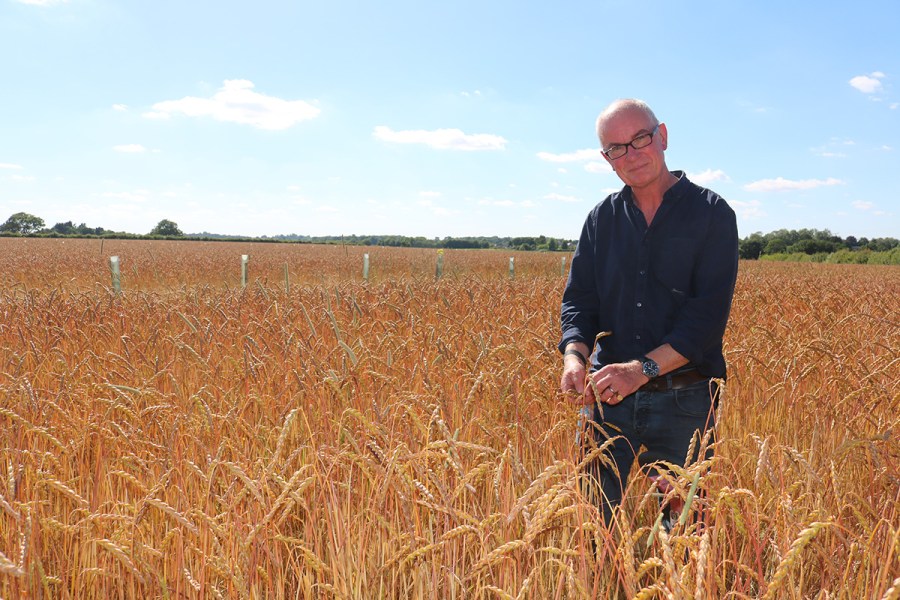Shimpling Park Farms in Suffolk has pioneered many of the practices currently followed by UK organic arable farms. CPM visits to gain an insight and explore their carbon credentials.
I view our activities in a different way to a conventional farmer. That’s not to say it’s the right way, but it feels right to me and it’s profitable.
By Tom Allen-Stevens
About half of the field John Pawsey walks into is taken up with an on-farm trial of sainfoin and lucerne that strike a deep contrast in colour against the surrounding cereals, now giving way their green to a golden hue.
The sainfoin is in flower and puts on a stunning display of pink next to the rich green of the lucerne. Meanwhile the remains of a soil pit dug for a recent demonstration suggest that what lies beneath the cover is of more interest than the foliage itself.
“This is the third year of a long-term trial that shrinks by 9m each year on either side as we take the herbal ley back into the field,” explains John. “We’re trying to understand the effect on our rotation and our soils of extending the leys within the organic cropping system we have.
“The aim is to gather as much data as we can about soil organic matter as well as yield and profitability. We’ve chosen to focus on sainfoin and lucerne because of their ability to root at depth – as we get these drier springs we want to understand how the changing climate will affect what we can crop.”
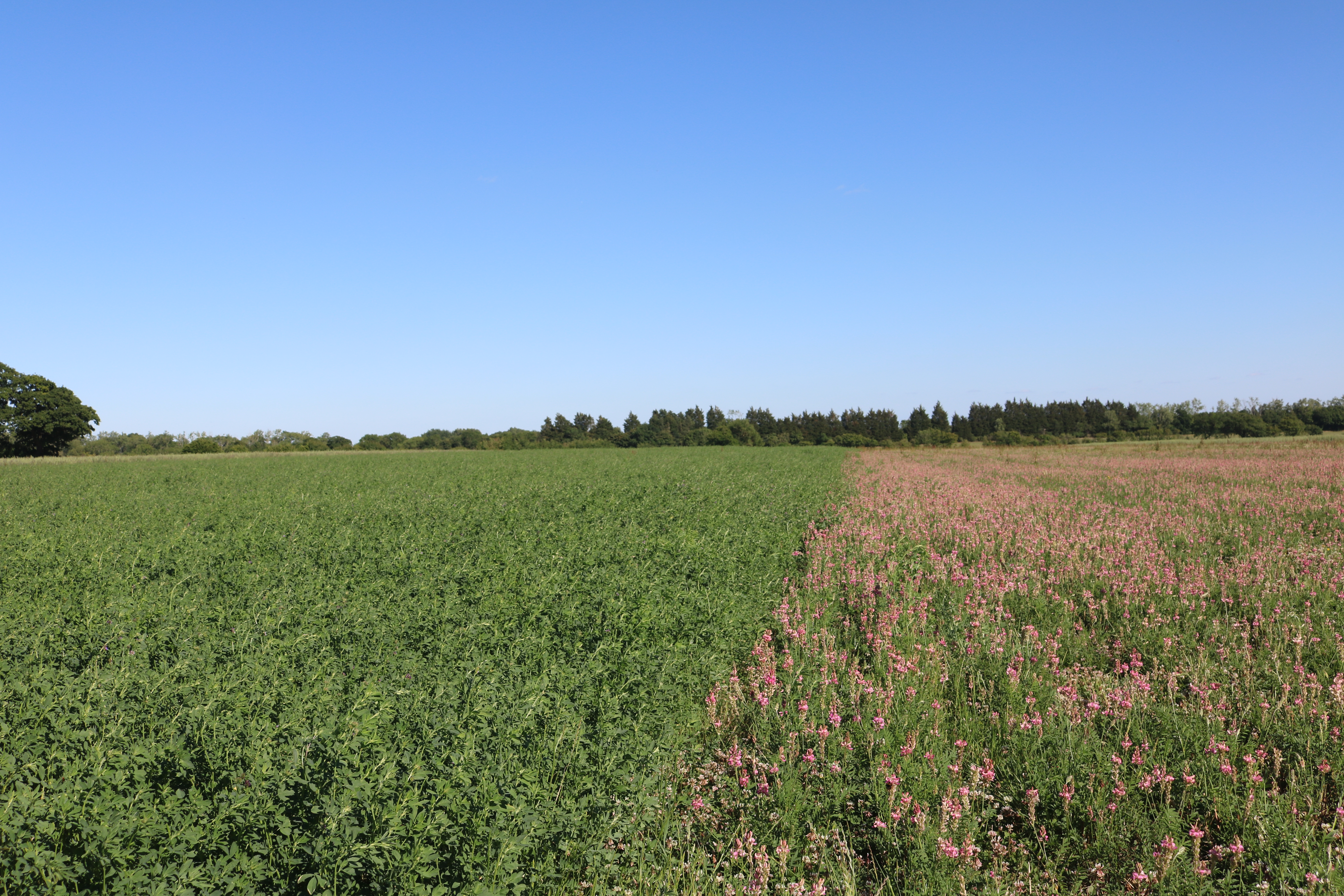
The sainfoin (right) is in flower and puts on a stunning display of pink next to the rich green of the lucerne.
Two cuts of haylage have already been taken from the trial and John’s confident there’ll be another from both crops before the summer’s out. He notes that the lucerne is “great at smothering weeds”, while as well as what you see in the sainfoin, it’s what you hear – the crop is buzzing with bees in a feeding frenzy.
So are the herbal leys delivering value? “I’ve no idea, but I view our activities in a different way to how a conventional farmer might consider them. That’s not to say it’s the right way, but it feels right to me and it’s profitable,” he says.
This is what John calls “farming by the gut”. “I don’t have enough time or resource to analyse every part of what we’re doing. But a lot of the benefits come from many different elements that mesh together. It’s a proper systems approach and there’s no one single metric that will validate it – you just have to rely on what sounds right.”
The first 120ha of Shimpling Park Farms, south of Bury St Edmunds, Suffolk, started its journey into organic conversion in 1999. Now all 650ha of the farm are fully organic, along with 850ha the business farms on contract. A six-year rotation puts the Hanslope series chalky boulder clay through two years of a herbal ley followed by four years of winter and spring cereals and a bean crop.
On the contract farms, there’s just a one-year break, to limit the hit on the cropping revenue. But at the home farm, John’s brought in a 1000-ewe flock of New Zealand Romneys that are paying dividends in more ways than one.
“The net margin of that part of the rotation has beaten everything because we’ve managed to sell the lamb well,” he reports. John says he was keen to bring livestock back into the arable rotation because he feels it’s an essential element of the organic system. Although labour costs of the enterprise are high, fixed costs of the flock that remain outside all year round are lower than the cropping enterprises, he explains.
“We’ve chosen this breed because we felt it suits a lowland grazing system. At 20%, we have quite a high culling rate which is hopefully improving and adapting the genetics. But I’m keen to lengthen the leys as they cost a lot to establish, and it gives a longer break to control weeds. The sheep ensure the leys are profitable and are also very beneficial for the soil.”
They graze the cover crops, too. “The most important element of this is to move them on frequently and back fence – that limits any compaction damage,” he notes.
The “green manure” forms another essential element of the system. Cover crops are only established in fields where the crop comes off early enough, with mid-August the cut-off date. Again, the emphasis is on diversity with a mix sown of buckwheat, mustard, vetch, phacelia and four types of clover – red, Persian, crimson and berseem.
“There are red and white clovers in the leys, so we only put a small amount of red in the cover crops. Persian and berseem clover offer differing rooting depths, and we want the mix to be weakened by frosts.”
So are these helping to increase yield? “I think it’s misleading to talk about yield and prefer to talk about financial output,” says John. It’s the cereals in the rotation that provide the bulk of this, and John walks over to the side of the lucerne where a seed crop of Golden Pheasant and Beavens Archer spring barley is ripening off.
“There’s a lot of interest in these heritage varieties, so we’re multiplying up the seed,” he explains.
The same approach to the market is taken with wheat. John travels next to a field of spelt wheat, the prime cereal crop that comes in after the herbal ley. “I do like growing spelt – it’s not only financially rewarding, it’s also a lovely looking crop at this time of year,” he remarks.
Here he takes a spade in an attempt to see whether the crop is as rewarding below the surface. Earthworm burrows and plenty of roots give evidence to the thriving environment he’s cultivating, although he’s clearly disappointed with the sun-baked clod that he’s extracted. “Digging a hole is always a key feature of farm visits and other farmers comment on the texture we achieve.”
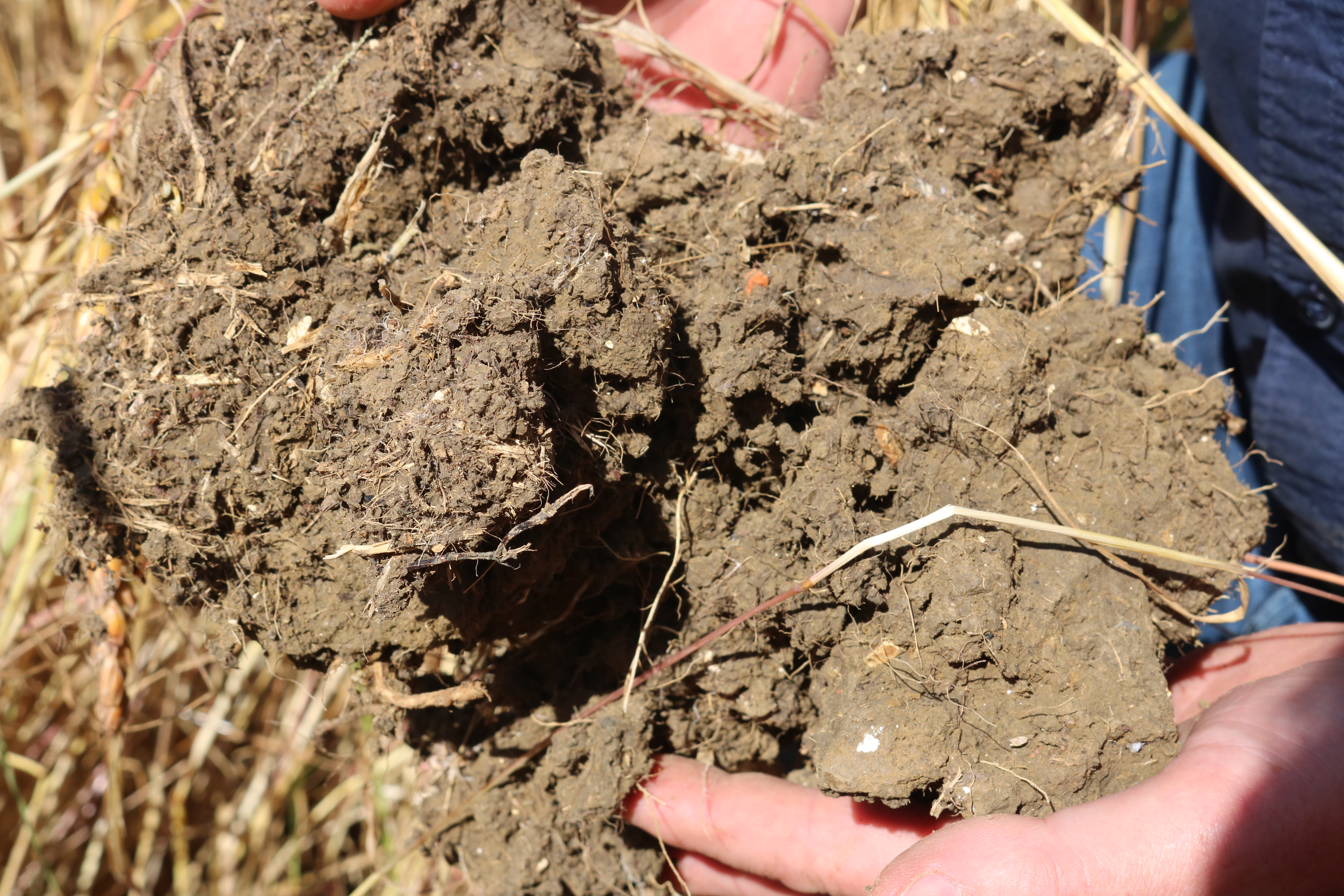
Earthworm burrows and plenty of roots give evidence to the thriving environment John’s cultivating.
Elsewhere in the rotation, wheat is also bi-cropped with beans. “A pulse in an organic rotation is essential to maintain fertility, but beans on their own are so inconsistent, and we have an enormous problem with chocolate spot. Yield varies from 4.6t/ha to just 0.75t/ha, which plays havoc with the cashflow,” explains John.
“Oats are super-competitive and don’t give the beans a chance, but wheat works well, producing two thirds of the total crop output. The beans also have the effect of boosting grain protein. It’s a tricky crop to establish – we used to drill the cereal and then come back in between the rows with beans, but now it’s all established together. This is a compromise for the ideal drilling date, but the bi-cropping definitely helps against chocolate spot.”
The other aspect that’s notable about the field of spelt wheat are lines of trees. 20ha has been planted with an agroforestry venture in 36m alleys. These complement and align with the farm’s approach to its trees – Alpheton Wood is a 12ha SSSI from which timber is sensitively coppiced, dried and then fed through the three biomass boilers that provide heating to the main farmhouse, converted outbuildings and cottages.
“Eventually the agroforestry trees will also bring us timber and woodchip, but they’re interesting as a diversification,” notes John. “Our aim is to crop the field so the entire six-year rotation is showcased within the alleys. That’ll provide interest for school visits and for wild camping.”
There’s good reason for the 36m width, too. As John walks back to the yard, he explains the farm’s controlled traffic farming system. “All cultivation equipment is either 4.4m or 8.8m, with the 9m header on the Claas combine also cutting 8.8m.
“Last year, there were areas where we went off the CTF system, and you could see to a line the compacted areas – in an organic crop, compaction is a killer.”
So in tandem with CTF, there’s a keen focus on tyre pressures. The Fendt tractors have the company’s Variogrip tyre inflation system that allows for pressure adjustments to suit field or road use. “We always try to use the widest tyres and that goes for trailers and field equipment, too,” he adds.
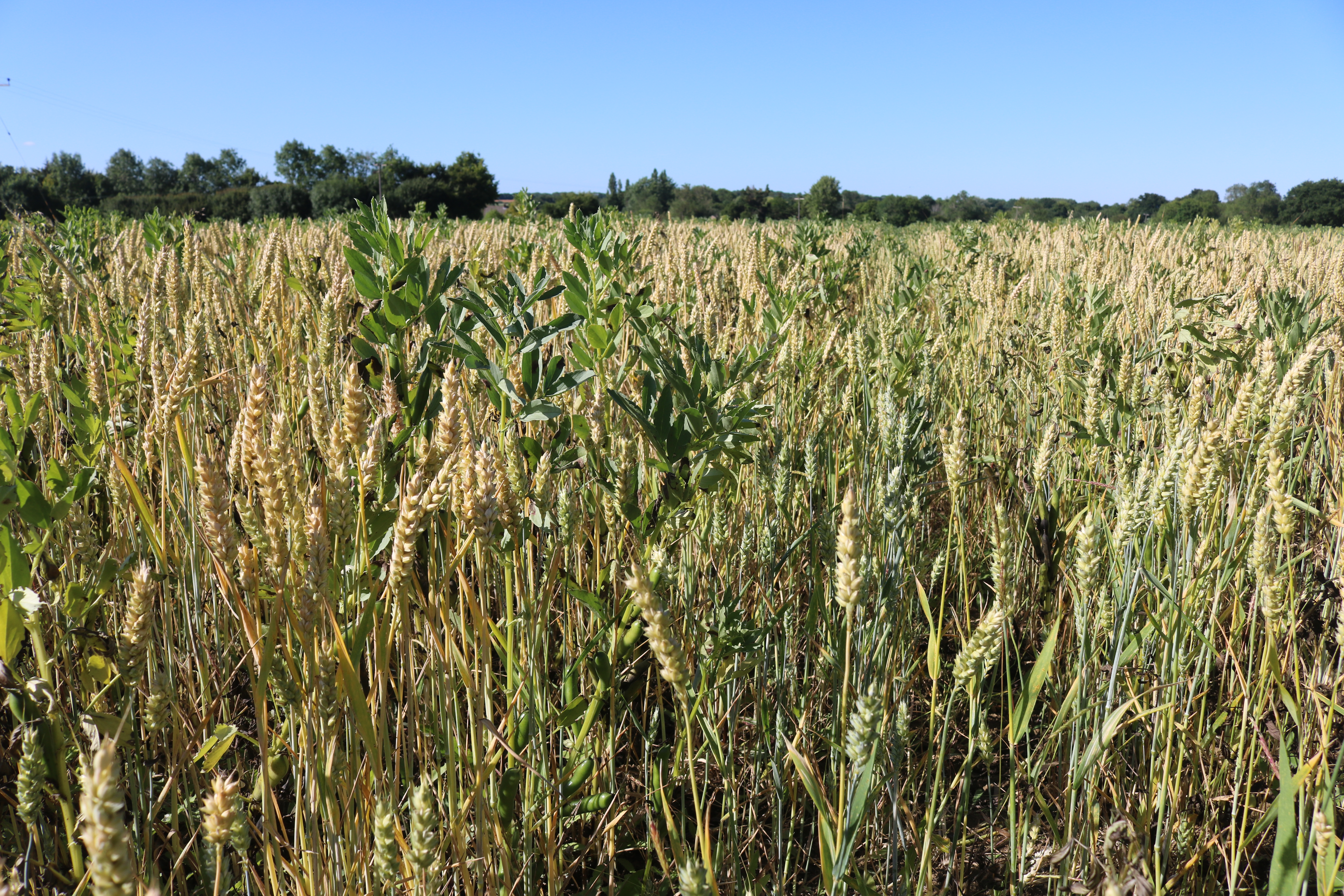
Wheat is bi-cropped with beans, which helps maintain fertility, reduce chocolate spot and boost grain protein.
With that, John gestures to the System Cameleon drill parked up in the yard, shod with BKT FL 630 Plus flotation radials. It’s one of two identical drills that have become another essential aspect of the organic system, providing the inter-row weed hoeing as well as establishing the crop.
“We’re reducing our cultivations and with our use of green manures have pretty much eliminated the plough. It’s still used in front of the wheat and beans and more on the contract farms where we’re more risk-averse. But when you’re not using herbicides, you need a complexity of cultivations so that no weed dominates. So I’ve stopped beating myself up about ploughing where it’s appropriate,” he says.
Wouldn’t that give regenerative growers who direct drill and use glyphosate a carbon advantage? “Organic farming is regenerative by definition,” counters John. “We did a five-year organic no-till trial, and very quickly problems with creeping thistle, couch and bromes appeared. Just a shallow cultivation keeps these at bay.
“But when you use a systemic herbicide to take out plant roots as well as foliage, you’re creating an imbalance in the soil – who knows what that does to the mycorrhizal fungi, for example?”
John accepts that the farm machinery he uses to keep weeds in check, which include various novel pieces of kit such as a weed-surfer and comb-cutter, may burn more diesel than a conventional farm with its sprayer. But he believes the impact on the system as a whole is generally more beneficial than a reliance on pesticides. “Our productivity per ha may be lower, but on this farm, it’s not just about growing crops. We’re looking to build all the other elements and increase biodiversity.”
Soil organic matter levels have risen from a base in 1999 of 2.9% to an average 5.5% today (range 4.5-6.5%). “We want to lift this further – our marker is the permanent pasture which is at 8-12%, and any kind of cultivation will clearly compromise our efforts to do so.”
This always makes for lively discussions during farm visits – John hosts around 20-25 every year, as well as talking at meetings held by agricultural clubs across the UK. “They’re a real pleasure because you meet so many interesting people, and I’ve made so many friends. The trick is not to be too serious or evangelical but to keep an open mind. It means you come away with even more ideas you want to implement, and the system becomes even more diverse, but I like that,” he says.
What makes John Pawsey a Climate Change Champion?
Innovative ideas
On-farm trials are a key source of new ideas through which John progresses his organic system Through farm visits and talks, he avidly exchanges knowledge with others, which enriches the farm’s diversity further.
Productivity push
Premium markets, bi-cropping and careful use of the farm’s herbal leys have all helped increase productivity, which for John includes biodiversity and soil health, as well the farm financials. All of this is currently done with very low emissions.
Cultivation care
Controlled traffic farming and a rigorous attention to tyre pressure have kept compaction in check. Use of the plough has been nearly eliminated at the home farm and cultivations are appropriately diverse to ensure weeds are under control. Soil organic matter has risen from 2.9% to 5.5% over 20 years.
Bio-based boldness
Biomass boilers are fuelled from home-grown woodchip and provide the heating for farmhouse, outbuildings and cottages. A 50kW solar array on the grain barn supplies commercial lets.
Trailer tyre technology is very much part of an agricultural revolution
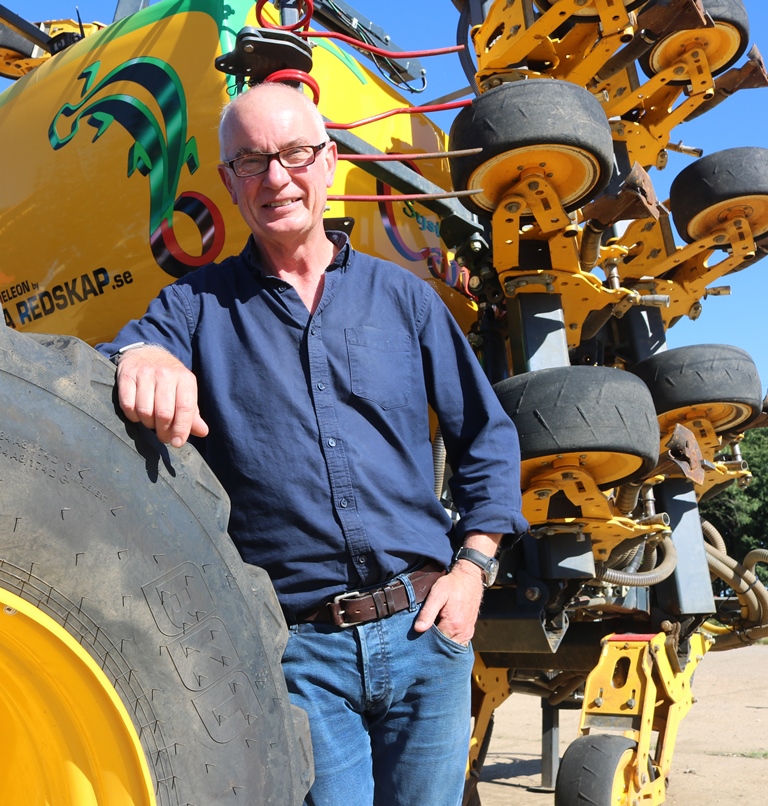
The flotation tyres on John Pawsey’s Cameleon drill are part of the system that ensures his
soil thrives.
There’s a revolution taking place as farmers worldwide respond to the challenges of climate change, according to leading tyre manufacturer BKT. Agriculture 4.0 brings together digitalisation, technology and sustainability.
Care for the soil forms a cornerstone of Agriculture 4.0 in any organic or regenerative farming system. BKT aims to revolutionise operations carried out in the field by using advanced technologies to increase efficiency, the sustainability of activities and production quality, says Denis Piccolo, product manager at BKT. That goes as much for trailers and equipment used in the field as it does for the tractors and combines.
“Agricultural machinery and equipment, including tyres, are also at the heart of this revolution,” he says. “The BKT Flotation range responds to the needs dictated by Agriculture 4.0 and to the new challenges in production and sustainability.”
This series of tyres has been specially designed to reduce compaction of the soil, preventing damage to the crops, he explains. “Another key feature of these tyres is their versatility, which allows users to move smoothly over long distances and on different terrains, without having to adjust tyre pressure and this makes the job a whole lot easier. What’s more, thanks to their footprint and excellent traction, BKT Flotation tyres allow significant fuel savings, improving cost efficiency.”
Denis highlights the V-Flexa, a radial tyre designed for agricultural trailers which incorporates VF (Very High Flexion) technology, allowing the transport of heavy loads with a 30% lower tyre pressure than a standard tyre of the same size.
“The latest generation V-Flexa range has a tread equipped with steel belts that makes the casing more resistant, preventing tears and penetration by foreign bodies. The FL 633 Performa has extreme resistance, durability and load capacity – perfect for activities in the fields as well as travelling on the road at up to 100 km/h,” he notes.
“Using tyre technology within a CTF system, John ensures his soils thrive. This is an excellent foundation for a sustainable and efficient system, which is why BKT is pleased to support his nomination as Climate Change Champion 2022,” concludes Denis.
Climate Change Champions
UK Farming has set itself the challenging target of Net Zero emissions by 2040. Although led by the NFU, it will take the entire industry, working together in a partnership approach to meet this ambitious goal.
But there are individual growers, thought leaders who have already started on this journey. They have the ideas, the progressive outlook and the determination to shape positive change. CPM has teamed up with leading agricultural suppliers who have a credible Net Zero aspiration to identify these individuals and bring them into the top-level discussion about how farming can position itself as the solution to climate change.
cpm-magazine.co.uk/climatechangechampions/
CPM would like to thank our sponsors:


